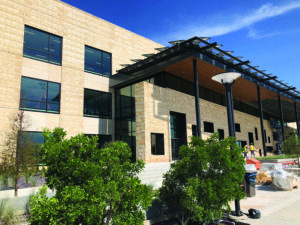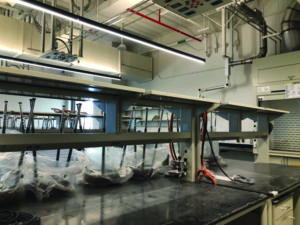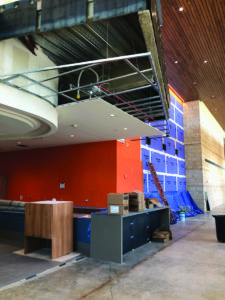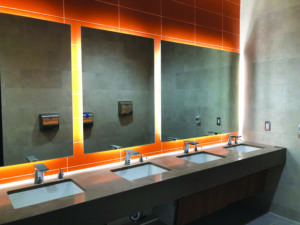Midland-Odessa takes another step forward. The long-awaited UTPB College of Engineering Building is now a reality.
One month. Four weeks. Thirty days. And counting.
Workers scampered from one end of the building, from top to bottom, and all over the outside grounds in an all-out push to finish the new College of Engineering Building for the University of Texas of the Permian Basin in time for the August 26 class start date.
It would be the culmination of years of dreaming, planning, and, finally, construction of the three-story structure housing four engineering disciplines: petroleum, mechanical, electrical, and chemical. From the flash of an idea to the first engineering class offered in 2009 to the new building opening its doors took 10 years.
Situated halfway between Midland and Odessa off FM 1788 and State Highway 191—what is called the epicenter of the petroleum-rich Permian Basin—the new Engineering Building will provide state-of-the-art equipment and technology in its labs, classrooms, collaboration areas, and computer rooms.
“The great opportunity here is we can grow the engineers,” said Dr. George Nnanna, dean of the UTPB College of Engineering. “They can then work in the region and this helps the Permian Basin economy. This is one of the key goals of (UTPB) President Sandra Woodley—to increase the workforce that is needed to grow the economy here. She’s been very active in driving that message.”
A tour of the building one month before the first day of classes reflected an urgency by workers to finish the two-plus year construction project. Led by David Wayland, AIA, associate vice president of facilities management at UTPB, he noted that when the building is completed they still have to move equipment and files from offices on the main campus.
“All the faculty has to get moved in,” he said. In addition, Wayland has to ensure that the 250 computers are installed and working, along with smart boards and other technology.
The 105,801-square-foot structure lists a total project cost of $55.1 million. The three-story building is encased in Hadrian limestone from the Garden City quarry and includes a metal panel veneer. Randomly placed windows on the front mimic the architecture of the Wagner-Noel Performing Arts Center, located east of the engineering building. Solar panels on the roof are designed to ease the heating/cooling costs. Additionally, perforated metal panels on the building’s west side in front of large windows reduce the sun’s afternoon glare.
Walking into the building, the first floor opens onto a long walkway with windows and a Student Café that will feature Starbucks coffee and a microwave. Vending machines will offer more than chips and candy. Stairs and elevators at each end provide access to the second and third floors. The first floor features a large lecture hall seating 108 people. Each floor includes two classrooms, each seating 42 students; 10 faculty offices; a 24-seat laboratory classroom; a Student Success Center; a computer lab; and four laboratories. Each lab will concentrate on a particular discipline: petroleum, chemical, mechanical, and electrical engineering with research labs. A special visualization lab is situated on the second floor.
An aerospace lab with a jet engine turbine exhaust and a wind turbine is set up for mechanical engineering students. Additionally, a large mechanical room supplies the building with its needs and shows students what is needed and how each piece works. A wet lab on the second floor will enable research into water needs. After UTPB received grants for supercomputers, a classroom was modified to add space for that equipment, Wayland said.
Dr. Nnanna arrived at UTPB one year ago to take over as dean. Originally from Nigeria, he earned a bachelor’s degree in mechanical engineering at Texas Tech University, and his master’s and Ph.D. in mechanical engineering from the University of Texas at Arlington. From 2007 to 2018 he led the Purdue Water Institute, which includes a water research laboratory that managed several multi-million dollar externally funded projects. Under his leadership at Purdue Northwest, the mechanical and civil engineering department saw increased enrollment; a doubling of research and scholarly activities and an increase in industrial partnerships; and growth in fundraising and endowments.
Being able to grow the engineering program as it moves into a new facility attracted Nnanna to the position in West Texas.
“In my first year here, we’ve added chemical and electrical engineering to the program,” he said. “We established an undergraduate research program and we now offer an internship plan where students can gain experiential learning with industry.”
The UT System awarded UTPB $1.8 million for five faculty members to establish a research program. When school started in late August, the engineering faculty included four professors moving to UTPB from other major universities, Dr. Nnanna noted.
New scholarship funds also are directed to 58 students to help them with their academic costs. “They can spend time focusing on their education,” he said.
As part of UTPB’s mission to grow the workforce, the department organized an engineering program for middle- and high schoolers, which was funded by XTO Energy. “We had 60 students and exposed them to various aspects of engineering,” he said.
This fall, UTPB is sponsoring a Water Lecture Series “to provide an opportunity for our students and industries to meet and discuss water issues in the Permian Basin,” he said.
“We have an engineering advisory board that includes representatives from large and small companies in the industry. And we are looking for endowed professorships to be funded by industry.”
 Area industries and citizens have offered support through serving on advisory committees and by contributing funds to ensure construction of new building and to support new programs. Midland Development Corporation donated $3 million toward building out the structure’s third floor for chemical and electrical engineering. When first designed, the third story was going to be a “shell” for future expansion.
Area industries and citizens have offered support through serving on advisory committees and by contributing funds to ensure construction of new building and to support new programs. Midland Development Corporation donated $3 million toward building out the structure’s third floor for chemical and electrical engineering. When first designed, the third story was going to be a “shell” for future expansion.
UTPB’s engineering program lists an enrollment of about 600 students: 100 in pre-engineering; 260, mechanical engineering; 180, petroleum; 58, electrical; and 29, chemical.
“One of every seven students at UTPB is an engineering major,” Dr. Nnanna said. “We want to double that enrollment.”
More students will be coming through a recently formed partnership with Midland College. “They can co-enroll in UTPB’s College of Engineering and at Midland College. This will make their transition from the two-year school to four-year seamless,” Dr. Nnanna said.
Designing the engineering program to be relevant to industry’s needs is a major goal of UTPB, according to President Sandra Woodley.
“We now have the lab space for the type of faculty we are bringing in on the research side. Our students will be learning the best from the best,” she said. “We’ve worked closely with industry leaders to make sure our programs are relevant to what they need. Almost 90 percent of our students passed the fundamentals engineering exam and that is 10 percent higher than the national figure.”
She credited Dr. Nnanna with increasing the number of internships for engineering students.
“One of the goals in our strategic plan is to significantly increase the hands-on learning with internships, co-ops, and capstone research projects with industry leaders,” Dr. Woodley said. “We see the hands-on learning aspect will further differentiate our program in the Basin. The student and employer both get to ‘kick the tires.’ Our students are great and we hear time after time that our students are smart, hard workers and they are hired quickly after graduation. The ability to get on-the-job training before they graduate gives industry a chance to see the quality we are producing here.
“Sometimes the students they hire from UT-Austin or Texas A&M don’t want to stay in the Basin long-term. But we have students who are here and who love it here.”
Mark Nicholas with Nicholas Consulting Group chairs the UTPB Engineering Advisory Board and explained its role. “I was involved in writing letters and conducting focus groups in the effort to bring engineering to UTPB. We started with mechanical. When some people suggested adding a Master’s program, the board instead recommended adding chemical and electrical.
“We are an industry voice,” Nicholas said. “The board is interested in serving the community and its needs. We don’t need the Master’s program. We need electrical and chemical engineers out here. Electrical engineering is very important to the petroleum industry. And we need chemical engineers. We’ve been going to New Mexico and Louisiana to hire people. The new engineering building is a tremendous investment in helping us hire people.”
He echoed Dr. Woodley’s point about hiring qualified people locally. “I am a graduate of UT-Austin and we are not having much success getting those graduates to come here.”
Internships are important, he added, to help students determine if that is the kind of work they want to do or if it’s the employer they want. “Each company has a personality,” Nicholas said.
With a growing enrollment, more professors, the latest technology, and industry partnerships, UTPB’s engineering program brings a level of expertise and education not previously available locally.
“This job is exciting,” Dr. Nnanna added. “It’s a great opportunity to be here and to work with the industry and with the community.”
Lana Cunningham is a freelance writer who has lived in Midland since it was a pleasant city of 60,000 people.









